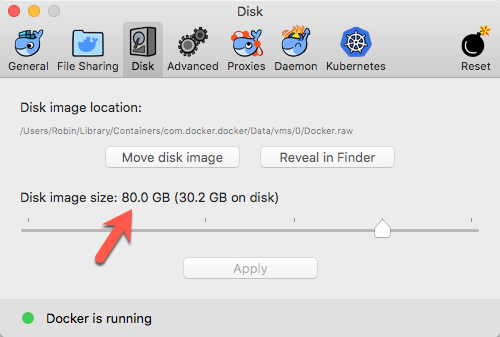

- #Osx docker image install
- #Osx docker image license
- #Osx docker image professional
If you’ve just installed the app, Docker Desktop launches the Quick Start Guide.
-allowed-org=: requires the user to sign in and be part of the specified Docker Hub organization when running the application. -accept-license: accepts the Docker Subscription Service Agreement now, rather than requiring it to be accepted when the application is first run. #Osx docker image install
The install command accepts the following flags: $ sudo /Volumes/Docker/Docker.app/Contents/MacOS/install We recommend that you also read the Blog and FAQs to learn how companies using Docker Desktop may be affected.Īfter downloading Docker.dmg, run the following commands in a terminal to install Docker Desktop in the Applications folder:
#Osx docker image license
You can choose to accept the terms at a later date by opening Docker Desktop.įor more information, see Docker Desktop License Agreement. If you do not agree to the terms, the Docker Desktop application will close and you can no longer run Docker Desktop on your machine. Docker Desktop starts after you accept the terms.
The Docker Pro, Team, and Business subscriptions include commercial use of Docker Desktop.Ĭlick the checkbox to indicate that you accept the updated terms and then click Accept to continue. The existing Docker Free subscription has been renamed Docker Personal and we have introduced a Docker Business subscription. There is a grace period until Janufor those that will require a paid subscription to use Docker Desktop. The effective date of these terms is August 31, 2021. #Osx docker image professional
It requires a paid subscription for professional use in larger enterprises. It remains free for small businesses (fewer than 250 employees AND less than $10 million in annual revenue), personal use, education, and non-commercial open source projects. Our Docker Subscription Service Agreement includes a change to the terms of use for Docker Desktop. It includes a change to the terms of use for Docker Desktop. The Docker menu ( ) displays the Docker Subscription Service Agreement window. In the example below, the Applications folder is in “grid” view mode. Install and run Docker Desktop on Mac Install interactivelyĭouble-click Docker.dmg to open the installer, then drag the Docker icon toĭouble-click Docker.app in the Applications folder to start Docker. Now Docker Desktop is completely uninstalled from your Mac.For more information, see Docker Desktop for Apple silicon. ~/Library/Application Support/Docker Desktop. (NOTE: It will be easy for you to use the “Go to Folder…” option from Menu bar > Go > Go to Folder… to locate these files and folders.) Similarly look for the following folders and files and move them to trash. In the Finder go to Library > Application Scripts >. Open the Finder > Applications folder and move the Docker.app to the trash. 
Now press the Uninstall button to uninstall Docker.Then go back to the Troubleshoot screen and press Reset to factory details button to remove the settings data.It may take several minutes for the purge process to complete. In the Troubleshoot screen press the Clean / Purge data button to remove all the containers and images in the machine.From the drop-down menu select Troubleshoot.Steps to cleanly uninstall Docker on macOS I have followed these steps to cleanly uninstall Docker on macOS system. However, most of them may leave traces of supporting files used by Docker in the system. There are several ways to uninstall the Docker Desktop on macOS.






 0 kommentar(er)
0 kommentar(er)
